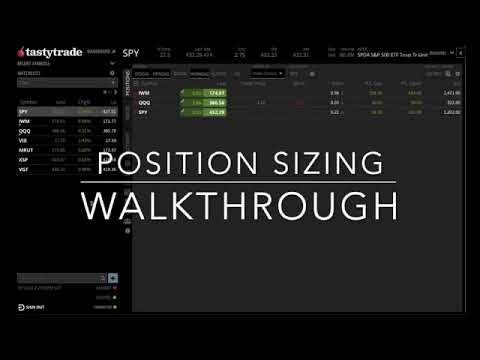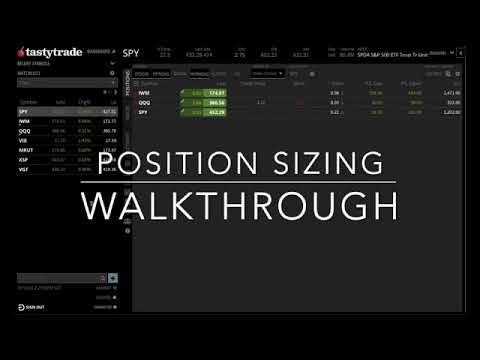In this video, titled “4-4 Position Sizing Walkthrough,” we will be exploring the concept of position sizing in trading. Specifically, we will be using the example of trading the SPY and focusing on a neutral strategy called the Jade Iron Condor. We’ll discuss how to choose the appropriate strikes for the put and call spreads, ensuring they don’t clash with each other or existing positions. Additionally, we’ll delve into the significance of risk per trade and how it impacts the width of the spreads. We’ll also touch upon adjustments that can be made to maintain a no-risk position to the upside and explore different options for position sizing based on account size and risk tolerance. This video is brought to you by Heating & Cooling Solutions, so let’s jump right in and learn how to effectively size our positions for optimal trading outcomes.

Position Sizing Walkthrough
Introduction to Position Sizing
Position sizing is a crucial aspect of trading that determines how many contracts or shares you should trade based on your risk tolerance and account size. It involves determining the appropriate size of your trades to ensure you can manage potential losses effectively while maximizing profits. In this article, we will explore the process of position sizing using the example of trading the SPY and implementing a neutral Jade Iron Condor strategy.
Example: Trading the SPY
To illustrate position sizing, we will focus on trading the SPY, which is the ETF that tracks the S&P 500 index. The SPY is a popular choice for options traders due to its high liquidity and tight bid-ask spreads. We will specifically discuss using UI version two, which refers to the Jade Iron Condor strategy and credit spreads when the credit spread is between 15 and 16.
Strategy: Neutral Jade Iron Condor
The neutral Jade Iron Condor strategy involves selling options spreads on both sides of the market to profit from sideways movement. It combines the features of the Jade Lizard and Iron Condor strategies. The put spread is selected with 16 to 20 Deltas, and in our example, we will use an 18 Delta. The call side is chosen with 30 to 35 Deltas. The goal is to construct a position that has no risk to the upside while being profitable if the price stays within a certain range.
Choosing the Put Spread
Determining Delta Range
The first step in selecting the put spread is to determine the range of Deltas that will be used. For a neutral Jade Iron Condor strategy, the typical range is between 16 and 20 Deltas. Delta represents the sensitivity of the option price to changes in the price of the underlying asset.
Selecting the Specific Delta
In our example, we will choose an 18 Delta for the put spread. This Delta strikes a balance between profitability and risk. By selecting an 18 Delta, we ensure that the option has a moderate chance of expiring out of the money, allowing us to keep the premium received from selling the spread.
Considerations for Risk per Trade
To manage risk effectively, it is important to determine the maximum amount you are willing to risk per trade. In our example, let’s assume our risk per trade is $500. This means that our total potential loss should not exceed $500 if the trade goes against us.
Calculating Spread Width
To calculate the spread width, we will start with a five-point wide spread since our risk per trade is $500. This means we will subtract five points from the short strike price for the put spread. If our short strike is 409, then the long strike will be 404, resulting in a five-point wide spread.
Avoiding Clash with Short Strikes
When selecting the put spread, it is crucial to ensure that the short strikes do not clash with each other or with any long positions on the same strike. Clashing strikes can lead to positions canceling each other out and potential losses. It is essential to carefully review your option chain and existing positions to avoid any clashes.
No-Risk Position to the Upside
To limit risk to the upside, we need to construct the call side of the Jade Iron Condor strategy. The call side is chosen with 30 to 35 Deltas. We want to select a long strike that ensures there is no risk above the short strike. By analyzing the premium, we can determine if the position is no-risk or if adjustments need to be made.
Choosing the Call Side
Determining Delta Range
For the call side, we will again consider the Delta range of 30 to 35. This range provides a good balance between profitability and risk.
Selecting the Specific Delta
In our example, we will choose a 35 Delta for the call side of the Jade Iron Condor. This Delta ensures that the probability of the option expiring out of the money is higher, allowing us to keep the premium received.
Considering Premiums
To ensure a no-risk position to the upside, we need to consider the premiums of the call spread. If the premiums do not cover the width of the spread, adjustments may be necessary to mitigate risk. In our example, the premiums of the call spread are sufficient to provide a no-risk position to the upside.
No-Risk Position to the Upside
By analyzing the premiums, we can confirm that our call spread provides a no-risk position to the upside. However, adjustments can be made to increase the width of the spread or further reduce risk if desired.
Adjustments for Risk per Trade
Wider Spread for Increased Risk
If the risk per trade increases, it may be necessary to select a wider spread to accommodate the higher risk level. In our example, we will consider a scenario where the risk per trade is $1,500. To align with this risk level, we will choose a 15-point wide spread.
Example: Adjusting for $1,500 Risk
By adjusting the spread width to 15 points, we ensure that our maximum potential loss aligns with our risk per trade of $1,500. It is important to note that wider spreads may introduce additional risks and should be carefully evaluated.
Handling Wide Wing Positions
When dealing with a wide wing position, it is essential to be cautious of missing strikes. Sometimes, there may be no strikes within the desired range, which can complicate position management. Careful analysis of strike availability is necessary to avoid unintended risks.
Avoiding Exceeded Risk
Adjustments may need to be made if the risk per trade exceeds the maximum allowed. This can include modifying strike prices, shift positions, or making changes to the width of the spreads. Regular monitoring and proactive risk management are vital to avoid exceeding risk limits.
Strike Prices and Premiums
Considering Premiums
Premiums play a crucial role in position sizing as they determine the potential profit and risk exposure of the trade. When selecting strike prices, it is necessary to consider the premiums and ensure they align with the desired risk and profit objectives.
Managing Risk
Strike prices should be chosen to manage risk effectively. By analyzing the premiums and strike selection, traders can ensure that the potential losses are within their risk tolerance. It is crucial to strike a balance between risk and profit potential.
Fulfilling Account Requirements
Strike prices can also be chosen to fulfill account requirements. Some brokers or trading platforms may have specific requirements for minimum strikes or option spreads. These requirements should be taken into account when selecting strike prices.
Choosing Expiration Dates
Factors to Consider
Choosing the right expiration date is essential to the success of a trade. Factors to consider include the desired length of the trade, expected market volatility during the chosen period, and potential news or events that could impact the underlying asset.
Decision-Making Process
The decision-making process for choosing expiration dates involves analyzing various factors such as expected market conditions, trading objectives, and risk tolerance. There is no one-size-fits-all approach, and traders should use their judgment to determine the most suitable expiration date for their specific situation.
Adjusting Position Size
Account Size and Risk per Trade
Account size and risk per trade are important considerations when adjusting position size. Traders with larger accounts may be able to take on larger positions, while those with smaller accounts may need to adjust their position size accordingly.
Options for Position Sizing
Multiple options are available for adjusting position size. This can include widening wings, using additional buying power, or increasing the contract size. Each option has its own trade-offs and considerations that should be evaluated to determine the most suitable approach.
Trade-offs and Considerations
When adjusting position size, there are trade-offs to consider. Higher premiums may lead to higher potential profits but also increase the risk exposure. Traders should evaluate these trade-offs based on their risk tolerance, profit objectives, and market conditions.
Conclusion
Position sizing is a critical aspect of trading that helps manage risk and maximize profits. By carefully selecting the put and call spreads, considering premiums, strike prices, and expiration dates, traders can effectively size their positions to align with their risk tolerance and account size. It is important to regularly review and adjust position sizes as market conditions, risk appetite, and account size change. Applying proper position sizing techniques can greatly enhance the success and sustainability of trading strategies.
